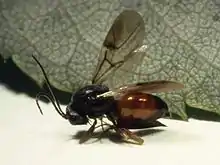Diplolepis (wasp)
Diplolepis is a genus of approximately 50 species in the gall wasp family Cynipidae.[1][2] The larvae induce galls on wild roses (Rosa), and rarely on domestic roses.[1][2][3]
| Diplolepis | |
|---|---|
 | |
| Diplolepis rosae gall | |
| Scientific classification | |
| Kingdom: | Animalia |
| Phylum: | Arthropoda |
| Class: | Insecta |
| Order: | Hymenoptera |
| Family: | Cynipidae |
| Tribe: | Diplolepidini |
| Genus: | Diplolepis |
Description
Adults are small (3–6 mm; 0.1-0.2 in) with a strongly arched mesosoma giving them a hunched appearance.[4] Coloration ranges from entirely orange to reddish-brown or black.[4] Larvae are legless and cream-colored with a weakly defined head.[4]
Galls formed by a given species can usually be distinguished from those of other species by the shape, size, placement, and ornamentation (smooth or spiny) of the gall, together with the identity of the host plant.[1][4] However, gall morphology can be modified by the presence of inquilines and parasitoids.[1][4] Some species induce galls on leaves, while others induce galls on stems or adventitious shoots.[1][4] Depending on the species of wasp, galls may be single-chambered or multi-chambered, and detachable or integral.[1][4]
Range
Diplolepis species occur throughout the holarctic region.[1][2] While most described species are in the nearctic, it is likely many species remain to be discovered and described, particularly in the eastern palearctic.[1][3]
Life cycle
All Diplolepis species lay eggs and induce galls only on rose (Rosa) species, and are thus dependent on roses to complete their life cycle.[1][4] There is only one generation per year.[1] Adult emergence from galls coincides with the availability of suitable host plant tissue required for oviposition and gall formation; this can be in spring and or later in summer depending on the species.[4] The adult life span is 5–12 days, during which they mate and the females lay their eggs.[4] Eggs are attached to 1-2 plant cells and gall formation begins before the eggs hatch.[4] Larvae are entirely surrounded by their galls shortly after they begin feeding.[4] Larvae remain in their galls during the summer while feeding on gall tissue, and mature by late summer.[4] They overwinter in their galls as pre-pupae; they complete pupation in spring and the adults chew their way out of the galls.[4]

Inquilines and parasitoids
The galls of nearly all Diplolepis species are known to host inquilines - species that invade and occupy a gall but do not feed on the larva of the inducing species, though the inducing larva often dies as a result of the activity of the inquiline.[1][4] Species of the gall wasp genus Periclistus are the most common inquiline species found in Diplolepis galls and may occupy over half the Diplolepis galls produced in a given year.[4]
The larvae of both the gall-inducing Diplolepis species and the inquilines (if present) are used as hosts by a number of parasitoid wasps, including wasps from the families Eulophidae, Eurytomidae, Chalcidae, Pteromalidae,Torymidae, and Ichneumonidae.[4][5][6]
Taxonomy
The name 'Diplolepis' was first used for this group by Etienne-Louis Geoffroy in 1762.[7] The genus is monophyletic and, with Liebelia, constitutes the tribe Diplolepidini within the subfamily Cyinipinae.[1][2] There are currently about 50 described species in the genus, including:[1][3][8]
- Diplolepis abei
- Diplolepis arefacta
- Diplolepis ashmeadi
- Diplolepis bassetti
- Diplolepis bicolor
- Diplolepis californica
- Diplolepis dichlocera
- Diplolepis eglanteriae
- Diplolepis flaviabdomenis
- Diplolepis fructuum
- Diplolepis fulgens
- Diplolepis fusiformans
- Diplolepis gracilis
- Diplolepis hunanensis
- Diplolepis ignota
- Diplolepis inconspicuis
- Diplolepis japonica
- Diplolepis lens
- Diplolepis mayri
- Diplolepis minoriabdomenis
- Diplolepis nebulosa
- Diplolepis neglecta
- Diplolepis nervosa
- Diplolepis nigriceps
- Diplolepis nitidus
- Diplolepis nodulosa
- Diplolepis oregonensis
- Diplolepis ostensackeni
- Diplolepis polita
- Diplolepis pustulatoides
- Diplolepis radicum
- Diplolepis radoszkowskii
- Diplolepis rosae
- Diplolepis rosaefolii
- Diplolepis similis
- Diplolepis spinosa
- Diplolepis spinosissimae
- Diplolepis terrigena
- Diplolepis triforma
- Diplolepis tuberculatrix
- Diplolepis tumida
- Diplolepis variabilis
- Diplolepis variegatus
- Diplolepis verna
- Diplolepis weldi
References
- Zhang, Y. Miles; Buffington, Matthew L.; Looney, Chris; László, Zoltán; Shorthouse, Joseph D.; Ide, Tatsuya; Lucky, Andrea (2020-12-01). "UCE data reveal multiple origins of rose gallers in North America: Global phylogeny of Diplolepis Geoffroy (Hymenoptera: Cynipidae)". Molecular Phylogenetics and Evolution. 153: 106949. doi:10.1016/j.ympev.2020.106949. ISSN 1055-7903.
- Ronquist, Fredrik; Nieves-Aldrey, José-Luis; Buffington, Matthew L.; Liu, Zhiwei; Liljeblad, Johan; Nylander, Johan A. A. (2015-05-20). "Phylogeny, Evolution and Classification of Gall Wasps: The Plot Thickens". PLOS ONE. 10 (5): e0123301. doi:10.1371/journal.pone.0123301. ISSN 1932-6203. PMC 4439057. PMID 25993346.
- Pujade-Villar, Juli; Wang, Yiping; Zhang, Wenli; Mata-Casanova, Noel; Lobato-Vila, Irene; Dénes, Avar-Lehel; László, Zoltán (2020-01-17). "A new Diplolepis Geoffroy (Hymenoptera, Cynipidae, Diplolepidini) species from China: a rare example of a rose gall-inducer of economic significance". ZooKeys. 904: 131–146. doi:10.3897/zookeys.904.46547. ISSN 1313-2970. PMC 6981308. PMID 32002012.
- Shorthouse, Joseph D. (2010-06-04), "Galls induced by cynipid wasps of the genus Diplolepis (Hymenoptera: Cynipidae) on the roses of Canada's grasslands", Arthropods of Canadian Grasslands (Volume 1): Ecology and Interactions in Grassland Habitats, Biological Survey of Canada, pp. 251–279, doi:10.3752/9780968932148.ch12, ISBN 978-0-9689321-4-8, retrieved 2020-11-12
- Mete, Özlem; Lotfalizadeh, Hossein (2019-07-01). "Parasitoid wasps associated with Diplolepis galls (Hymenoptera: Cynipidae) in Turkey: an updated checklist and report of three non-regular species". Phytoparasitica. 47 (3): 361–374. doi:10.1007/s12600-019-00740-3. ISSN 1876-7184.
- Abe, Yoshihisa; Melika, George; Stone, Graham N. (2007-01-01). "The diversity and phylogeography of cynipid gallwasps (Hymenoptera: Cynipidae) of the Oriental and eastern Palearctic regions, and their associated communities". Oriental Insects. 41 (1): 169–212. doi:10.1080/00305316.2007.10417504. ISSN 0030-5316.
- Geoffroy (1762). Histoire abregée des insectes. Paris: Durand. doi:10.5962/bhl.title.65744.
- Krombein, Karl V. (1979). Catalog of hymenoptera in America north of Mexico. Washington: Smithsonian Institution Press. doi:10.5962/bhl.title.5074.